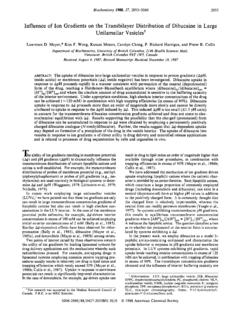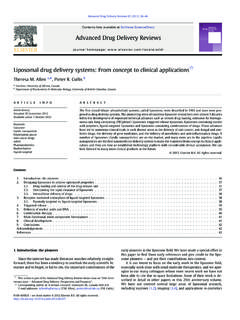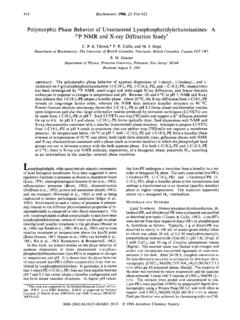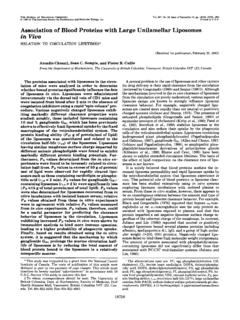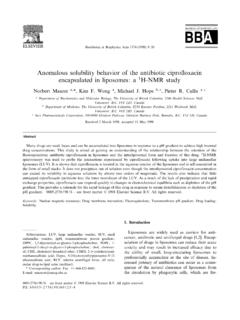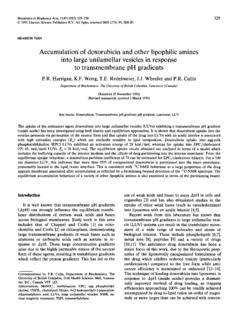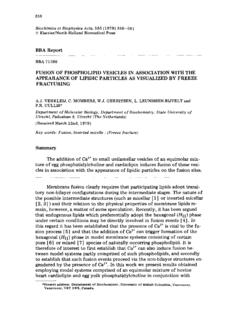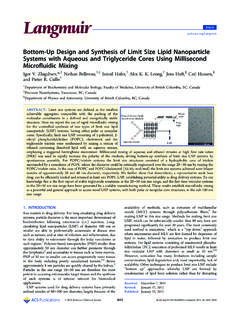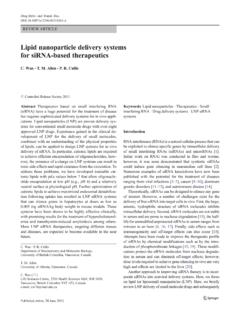Transcription of The Use of Transmembrane pH Gradient-Driven …
1 JOURNAL OF LIPOSOME RESEARCH, 4(1), 529-553 (1994) THE USE OF Transmembrane PH Gradient-Driven drug encapsulation IN THE PHARMACODYNAMIC evaluation OF LlpoSOMAL DOXORUBICIN Lawrence D. Mayer", Pieter R. Cullis2 and Marcel B. Bally' 'The British Columbia Cancer Agemy, Division of Medical Oncology, 600 West 10'" Ave., Vancouver, V5Z 4E6 Canada 'The University of British Columbia., Department of Biochemistry, 2146 Health Sciences Mall, Vancouver, V6T 123 Canada ABSTRACT The toxicity and efficacy properties of doxorubicin entrapped inside liposomes are sensitive to the physical characteristics of the vesicle carrier system. Studies addressing such relationships must use preparation procedures with the ability to independently vary vesicle size, lipid composition and drug to lipid ratio while maintaining high trapping efficiencies.
2 The Transmembrane pH Gradient-Driven encapsulation technique allows such liposomal doxorubicin formulations to be prepared. Pharmacokinetic, toxico1og:y and antiturnour studies with these systems have revealed several important relatio'nships between liposome physical properties and biological activity. The acute toxicity of liposomal doxorubicin is related primarily to the ability of the 1iposomt:s to retain doxorubicin after administration. Including cholesterol and increasing the degree of acyl chain saturation of the phospholipid component in the liposomes significantly decreases drug leakage in the blood, reduces cardiac tissue of doxorubicin and results in increased LD,,values.
3 In contrast, the efficacy 01' liposomal doxorubicin is most influenced by liposome size. Specifically, liposomes with a diameter of approximately 100 nm or less exhibit enhanced circulation lifetimes and antitumour activity. While these relationships appear to be rather straightforward, there exist anomalies which suggest 529 Copyright 0 1994 by Marcel Dekker, Inc. Journal of Liposome Research Downloaded from by University of British Columbia on 08/21/12 For personal use MAYER, CULLIS, AND BALLY that a more thorough evaluation of liposomal doxorubicin pharmacokinetics may be required in order to fully understand its mechanism of action. A key feature in this regard is the ability to differentiate between non-encapsulated and liposome encapsulated doxorubicin pools in the circulation as well as in tumours and normal tissues.
4 This represents a major challenge that must be addressed if significant advances in the design of more effective liposomal doxorubicin formulations are to be achieved. INTRODUCTION The sophistication of liposomal systems used to deliver doxorubicin intravenously has increased significantly since their utility in improving the therapeutic index of this drug was first reported (1,2). The vesicle carriers employed for this purpose have progressed from heterogeneous multilamellar vesicle (MLV') or sonicated SUV preparations containing various anionic phospholipids that complex doxorubicin, to homogeneously sized liposomes containing lipid species that impart enhanced biological effects, and in some cases attached antibodies that impart tumour targeting characteristics (1-8).
5 This progression was initially limited by constraints involved in the production of well defined liposomal systems as well as in the ability to effectively entrap and retain doxorubicin inside liposomes. Liposome preparation and encapsulation techniques have improved significantly over the last 10 years and it is now possible to optimize liposomal doxorubicin formulations on the basis of desirable toxicology and efficacy properties. This optimization process is based on selective changes in the physical attributes of the liposomal carrier. The importance of vesicle size, surface charge and dose in determining the fate of intravenously administered liposomes is well established (see ref.)
6 9 for review). It is therefore not unexpected that manipulations of these parameters can cause significant changes in the pharmacokinetic, toxicity and efficacy behaviour of liposomal doxorubicin. Given the complicated matrix of size, lipid composition and drug to lipid ratio (equivalent to lipid dose) combinations possible for a liposomal preparation of doxorubicin, it is imperative that these properties can be varied independently if their biological influences are to be clearly elucidated. We have found the pH gradient-dependent doxorubicin entrapment technique to be p?.kularly useful in this regard. In this procedure, doxorubicin is sequestered into preformed liposomes displaying a pH gradient (inside acidic) under conditions where trapping Journal of Liposome Research Downloaded from by University of British Columbia on 08/21/12 For personal use pH GRADIENT 53 1 efficiencies approach 100% (4,lO).
7 Further, this encapsulation method can be effectively used for a wide variety of liposome types. As a result, liposomal doxorubicin formulations differing only in one property can be generated and their toxicity or efficacy responses in animal models compared. In this report we describe the use of the pH Gradient-Driven encapsulation procedure to reveal the influence of vesicle physical properties on the pharmacodynamics of liposomal doxonibicin. The studies presented here demonstrate that the toxicity and efficacy of liposomal doxorubicin are dependent on different formulation characteristics. In addition, the importance of differentiating between liposome-associated and free drug pools in the blood compartment and tissues is addressed.
8 MATERIALS AND METHODS Materials All phoshpolipids were obtained from Avanti Polar Lipids (Birmingham, AL). Cholesterol and other reagent grade chemicals were purchased from Sigma Chemicals (St. Louis, MO). Doxorubicin was purchased from Adria Laboratories (Mississauga, Ont., Canada) and 3H-choleste~lhexaclec~l ether was obtained from New England Nuclear (DuPont, Canada). CD-1, BDF1 and DBA/2J mice, 6-8 weeks old, were obtained from Jackson Animal Laboratories. Methods Liposome Preparation. Lipid mixtures were prepared in chloroform solution and subsequently dried under a stream of nitrogen gas. The resulting lipid film was placed under high vacuum for a minimum of 2 h. Multilamellar vesicles (100 mg/ml) were formed by hydrating the dried lipid with 300 mM citric acid @H ).
9 The resulting preparation was frozen and thawed 5 times prior to extrusion 10 times through two stacked polycarbonate filter!; of the indicated pore size (1 1). When DSPC or DPPC were employed the sample and extrusion apparatus (Lipex Biomembranes Inc., Vancouver, , Canada) were heated to 5 C above the thermotropic phase transition temperature of the phospholipid prior to extrusion (12). Liposome particle size was determined by quasielastic light scattering (QELS) measurements (employing a Nicomp 370 particle sizer operating at. a wavelength of nm). Journal of Liposome Research Downloaded from by University of British Columbia on 08/21/12 For personal use MAYER, CULLIS, AND BALLY Doxorubicin encapsulation .
10 Doxorubicin was encapsulated in liposomes in response to Transmembrane pH gradients as described previously (4,lO). Briefly, the pH of the liposome suspension, initially at pH , was raised to pH with M Na,CO,. The liposome preparation was subsequently heated to 60'C for 5 min. and then transferred to a preheated (60'C) vial of doxorubicin, adding enough lipid to achieve the indicated drug to lipid ratio. This mixture was incubated with intermittent mixing for 10 min. at 6O'C. Doxorubicin concentration, lipid concentration and encapsulation efficiency were determined as described previously (4). Solutions for injection were prepared with sterile physiological saline such that the specified dose could be delivered in 200 pl.
